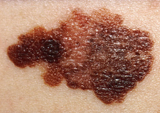
Skin Cancer Screening or Surgery
Skin cancer is the most common form of human cancer. It is estimated that over one million new cases occur annually in the United States. The most common warning sign of skin cancer is a new growth or a sore that will not heal. Sun exposure is the leading cause of skin cancer, and people with fair skin and light eyes that burn easily are at a particularly high risk. Fortunately, most cases of skin cancer can be detected in its early stages, and therefore when diagnosed early, it can be 100% treatable.
The term “skin cancer” refers to three different conditions, namely basal cell carcinoma, squamous cell carcinoma (the first and earliest stage is known as actinic keratosis) and melanoma.
Preventing skin cancer
The main cause of skin cancer is an over-exposure to ultraviolet (UV) radiation from the sun or tanning booths, especially if it results in burnt and blistered skin. Excessive UV radiation produces genetic mutations in the skin’s cellular DNA that can lead to skin cancer. Preventing skin cancer begins with vigilant sun avoidance and sun protection.
Here are some protective measures that you should take:
.Avoid the sun and seek shade outdoors. Ultraviolet rays are at their most intense between 10 am and 4 pm.
.Wear protective clothing when outdoors in the sun. Light colored, tightly woven and loose fitting clothing like long sleeved tops and pants provide an additional barrier between your skin and the sun. Also try to wear a wide-brimmed hat. A shade cap (which looks like a baseball cap with protective fabric draping down the sides and back) is also good option.
.Apply a broad-spectrum sunscreen that protects against UVA and UVB rays, with an SPF (Sun Protection Factor) of at least 30 every day. Sunscreens should be used on children as early as over the age of six months.
.Reapply sunscreen every two hours, or immediately after swimming or excessive sweating.
.Children under six months of age should be kept out of the sun. If it is impossible to avoid the sun, sunscreen should be applied.
.Remember that wearing sunscreen is never an excuse for increasing sun exposure and should be part of a program for sun avoidance.
Detecting skin cancer early
The early detection and removal of a skin cancerous growth offers the best chances of a cure.
Periodic self-examination is recommended, to aid your own recognition of any new or changing lesions that may have to be looked at by a dermatologist. Try to familiarize yourself with your own skin pattern of moles and freckles and examine yourself in a mirror every one to two months. Look for changes in the number, size, shape and color of your pigmented spots and consult your dermatologist promptly if you notice any changes.
Melanoma
Malignant melanoma is the most aggressive and deadly of all skin cancers. It occurs when melanocytes (cells responsible for producing pigment in the skin) start to grow out of control. Melanoma can develop anywhere on the skin, appearing as a new dark spot or bump, or as a change in or near an existing mole. Melanoma can demonstrate different shades of brown or black, and sometimes may even be pink or white
Individuals at high risk should be examined by a dermatologist on a regular basis.
More about moles, risk factors and the ABCDEs of melanoma
Squamous cell carcinoma
Squamous cell carcinoma is the second most common type of skin cancer. It typically manifests itself as a slow growing, scaly or crusted lump that may feel tender to the touch, and develop sores or ulcers that fail to heal. Sometimes, squamous cell carcinoma may simulate the appearance of a wart. These are commonly found on sun-exposed areas of the face, lips, ears, forearms, hands, and lower legs. Early recognition and treatment is especially important as this form of cancer has the potential to metastasize (spread to other parts of the body).
Apart from exposure of ultraviolet light, other risk factors include an inherited predisposition, smoking, thermal burn scars, long-standing leg ulcers, immunosuppressive drugs such as ciclosporin, azathioprine, especially in organ transplant recipients.
The treatment of squamous cell carcinoma depends on its size and location. In most situations, a full thickness surgical excision is performed to cut out the lesion completely. Large tumors may require the expertise of a plastic surgeon to repair the surgical defect. Radiotherapy (treatment using X-rays) is sometimes used for high risk skin cancer that appears on the face and for metastatic disease.
Basal cell carcinoma
Basal cell carcinoma (BCC) is the most common type of skin cancer and typically affects adults with a fair complexion who have had a lot of sun exposure. It slowly grows over months or years and can vary in appearance, resembling a fleshy bump, ulcerated nodule, red patch or even melanoma. This type of skin cancer rarely metastasizes (spreads to other parts of the body), however it can cause considerable damage by extending below the skin to the underlying bone and nerves.
Depending on the type of BCC, it may be treated by surgical methods, cryotherapy, topical creams (Imiquimod) or radiotherapy. People with BCC are also at an increased risk of developing further BCCs and other forms of skin cancer, therefore regular and complete skin examinations are advised. Protecting your skin from further damage by ultraviolet radiation is paramount.
Related Treatment:
Biopsy / Skin Surgery
Cryotherapy
Mole Screening


